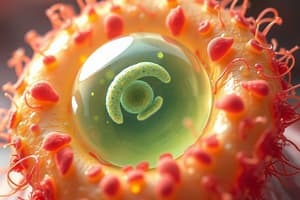Podcast
Questions and Answers
What discovery is Robert Hooke known for?
What discovery is Robert Hooke known for?
Robert Hooke is known for discovering cells and coining the term 'cells'.
How did Leeuwenhoek contribute to microbiology?
How did Leeuwenhoek contribute to microbiology?
Leeuwenhoek contributed by constructing microscopes and being the first to accurately observe and describe microorganisms.
What materials did Leeuwenhoek use to construct his microscopes?
What materials did Leeuwenhoek use to construct his microscopes?
Leeuwenhoek used double convex glass lenses held between two silver plates to construct his microscopes.
What term did Leeuwenhoek use to describe the tiny organisms he observed?
What term did Leeuwenhoek use to describe the tiny organisms he observed?
What did Robert Hooke observe to define what he called 'cells'?
What did Robert Hooke observe to define what he called 'cells'?
What were the main limitations in the development of microbiology for 200 years?
What were the main limitations in the development of microbiology for 200 years?
What did Francesco Redi's experiments demonstrate regarding spontaneous generation?
What did Francesco Redi's experiments demonstrate regarding spontaneous generation?
How did John Needham's experiments contribute to the debate on spontaneous generation?
How did John Needham's experiments contribute to the debate on spontaneous generation?
What improvement did Lazzaro Spallanzani make to Needham's experiments?
What improvement did Lazzaro Spallanzani make to Needham's experiments?
What role did Leeuwenhoek play in the context of spontaneous generation and microbiology?
What role did Leeuwenhoek play in the context of spontaneous generation and microbiology?
Flashcards are hidden until you start studying
Study Notes
Robert Hooke
- First to discover cells
- Used a compound microscope to study the bark of a cork tree
- Observed empty cell walls of dead plant tissue
- Called the pores "cells" because they reminded him of the cells inhabited by monks living in a monastery
Antony van Leeuwenhoek
- Published extensive, accurate observations of microorganisms
- Constructed simple microscopes with double convex glass lenses
- Microscopes could magnify around 50 to 300 times
- Observed a variety of things like rainwater, pond water, and scrapings from his own teeth
- Saw minute moving objects and called them “animalcules”
- First to record microscopic observations of muscle fibers, blood cells, algae, etc.
Spontaneous Generation
- Belief that living organisms could develop from non-living matter
- Challenged by Francesco Redi who conducted experiments on decaying meat and its ability to produce maggots
- The discovery of microorganisms renewed the controversy
- John Needham argued that boiled extracts of hay or meat gave rise to microorganisms after a while, even though larger organisms did not
- Lazzaro Spallanzani improved on Needham's experiments by sealing glass flasks containing broth
- Spallanzani found that if the flasks were sealed and placed in boiling water for 45 minutes, no growth took place
- He proposed that air carried germs to the culture medium
- Theodore Schwann allowed air to enter a flask containing a sterile nutrient solution after the air had passed through a red-hot tube. The flask remained sterile
- Georg Friedrich Schroder and Theodor von Dusch allowed air to enter a flask of heat-sterilized medium after it had passed through sterile cotton wool. No growth occurred
Louis Pasteur
- Proved the theory of biogenesis
- Discovered that yeast (unicellular fungus) was responsible for alcohol fermentation
- Concluded that fermentation is caused by microorganisms
- Solved the problem of wine and beer souring by heating wine to only about 50–60 °C for a short time to kill the microbes
- This process is known as "pasteurization"
- Proposed the “Germ theory of disease” which states that microorganisms are responsible for diseases
Robert Koch
- Provided the first direct demonstration of the role of bacteria in causing disease
- Used Koch’s postulates to establish the relationship between a causative agent and its disease
- His postulates are:
- The microorganism must be present in every case of the disease but absent from healthy organisms
- The suspected microorganisms must be isolated and grown in a pure culture
- The same disease must result when the isolated microorganism is inoculated into a healthy host
- The same microorganism must be isolated again from the diseased host
- Discovered that anthrax was caused by a rod-shaped bacterium, Mycobacterium tuberculosis
- Also discovered that cholera is caused by Vibrio cholerae
- Developed more reliable and reproducible growth media employing liquid nutrient solutions solidified with gelatin, and later with agar
- With Walther Hesse, Koch discovered that colonies developed on solid surfaces
- Koch reasoned that each colony harbored a population of identical cells, that is, a pure culture
Ferdinand Cohn
- Discovered the existence of heat-resistant bacterial endospores
- Experimenting with sterile infusions from dried hay, Cohn concluded that microorganisms might exist in thermostable forms (spores) which become active when proper nutrients are available
Joseph Lister
- Developed a method to destroy microorganisms in the operating theater by spraying a mist of carbolic acid (phenol) into the air
- Applied dressings soaked in carbolic acid on wounds
- Successfully prevented postoperative sepsis by introducing antiseptic techniques
Alexander Fleming
- Began a series of experiments involving the common bacteria, Staphylococcus aureus
- Discovered penicillin — a fungus that killed Staphylococcus aureus
Studying That Suits You
Use AI to generate personalized quizzes and flashcards to suit your learning preferences.




